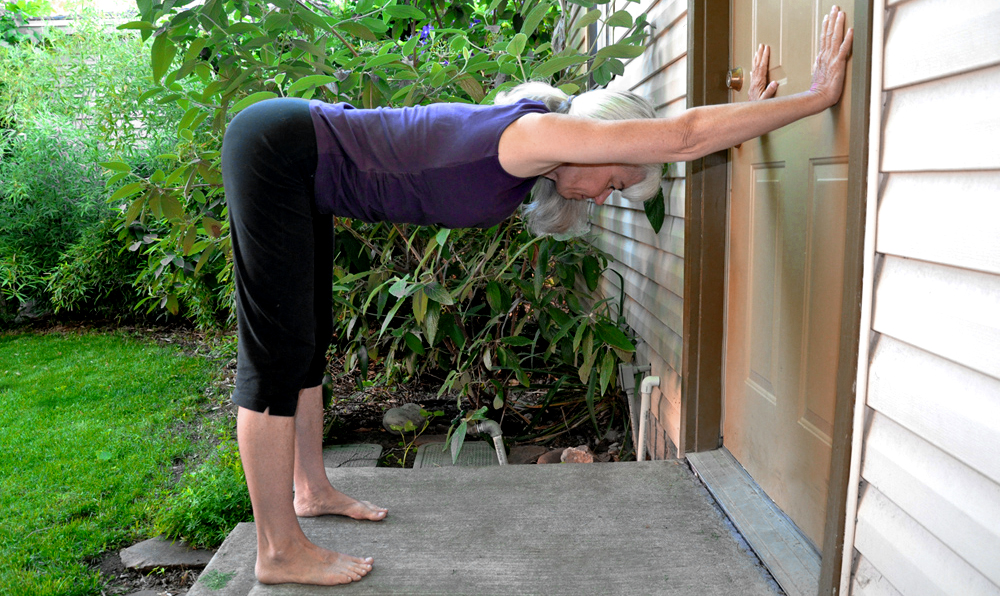
In spring and summer, my students make a whole lot of requests for low back and mid-back relieving poses. When I ask them why they’re needing these poses, the response is almost always, “I worked in the garden last weekend.” Gardening is a satisfying hobby. There’s nothing like seeing—and consuming—the fruits of your labor. But it’s not always easy on the body.
Shoveling, squatting, kneeling and bending over—the forms your body has to assume to get your garden ready for planting—all take a toll, especially when we likely haven’t been doing these things much over the winter. Here are some tips on how to minimize the effects of some of gardening’s most popular positions:
- Shoveling: One of the problems with shoveling is that it’s asymmetrical. Most of us have developed a habit of always using the same foot to press on the shovel, so we always toss the dirt in the same direction. Try giving equal time to each side. Shoveling on your less-utilized side may be a bit awkward at first, but it could help alleviate some of the overuse problems that can come from shoveling.
- Squatting: Not everyone can squat. Some people’s knees don’t flex deeply enough, while others’ ankles are constructed in such a way that they won’t bend past 90 degrees, so their heels won’t touch the ground. If you want to squat, but your heels won’t touch the ground, try elevating them by wedging a Yoga Wedge (in cork or foam) under your heels. That way the balls of your feet won’t have to support all your weight.
- Kneeling: Kneeling can be a good alternative to squatting. If kneeling is your position of choice, definitely use a kneeling pad. They’re available at most gardening stores and websites.
- Bending forward: Bending forward is the best alternative for people whose knees have limited motion. When you bend forward, bend your knees and extend your tailbone back so that your femur heads move back in their sockets, and your pelvis and spine can move together. However, don’t do any heavy lifting from a forward-bending position.
Yoga for Gardening
Gardening is not unlike sitting at the computer for long stretches. When you sit at a computer for hours at a time, it’s important to stand up, walk around and stretch a little at regular intervals—every 10 to 15 minutes. The same is true in gardening. My observation over the years is that my students who garden feel most of the subsequent stress in their low to middle backs. Yoga can help, but not just while you’re on your mat. Try weaving some yoga breaks into your gardening practice.
I like to incorporate movements that counteract the effects of the flexion inherent in all the above positions and move the spine in all its other possible directions—extension, rotation, lengthening and lateral bending. Here are some suggestions for poses you can practice while you’re in the garden. Stay in each pose for five to ten deep breaths:
Palm Tree Pose (extension and lateral bending):
- Stand with your feet hips-width apart.
- Raise your arms up toward the sky. Separate your arms to about a 45-degree angle.
- Grounding your feet lean back and open your heart to the sky, reaching out through your arms. Let your jaw open and drink in your breath.
- Come back to neutral standing. Raise your arms toward the sky and grab your right wrist with your left hand.
- Grounding your right foot, bend to the left. Repeat on the other side.
Wall Dog (lengthening):
- Stand in front of a vertical surface—a fence, shed, garage or your house.
- Place your hands on the wall in front of you.
- Walk your feet back or forward so that they are directly under your sit bones.
- Press into the wall to extend your sit bones back. You may need to walk your hands up the wall to feel a connection between the hands and sit bones.
Revolved Triangle Prep (rotation):
- Stand about 6 to 12 inches from your wall, facing away from it.
- Separate your feet to about a leg length apart. Turn your right foot 90 degrees to point forward.
- Move your left foot another 8 to 12 inches away from the wall and turn it to face forward, as you turn your whole body to face forward (toward the right leg).
- Descend your left heel (it’s okay if it doesn’t touch the ground) and rotate your entire leg—ankle, shin, knee, thigh and pelvis—inward so that the entire leg is in agreement with itself and with your pelvis. Now rotate your upper torso toward the wall and place your hands on the wall to support the twist.
Practicing yoga for gardening should help alleviate some of the aches and pains that can arise later on. You can play with how to incorporate them, sometimes doing all of them in succession, or doing one or two at a time. Getting on your yoga mat for some slow, gentle stretching after you’ve finished for the day can help too. Taking care of your body during and after a gardening will set you up for another glorious day in the dirt.
